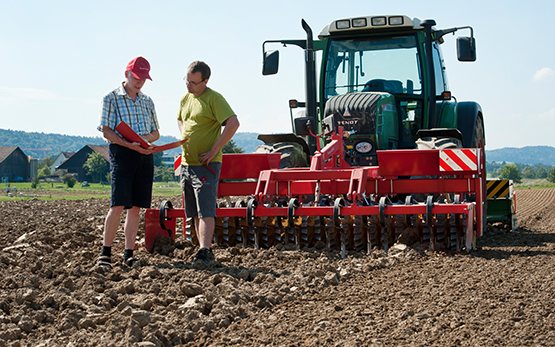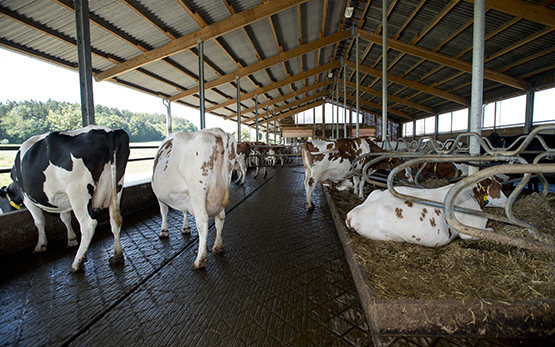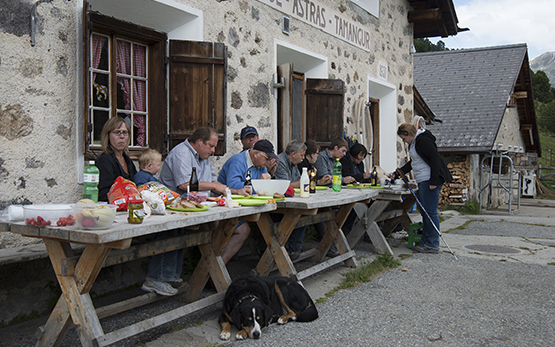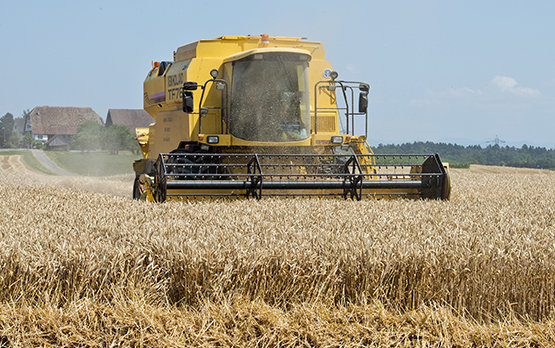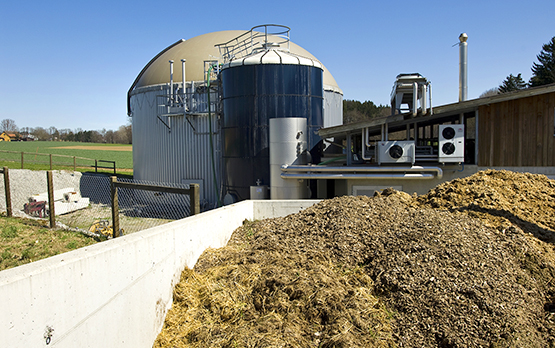Bürge I., Kasteel R., Krauss J., Pétremand H., Zeender V., Poiger T.
Detection of the herbicide asulam in groundwater: Translocation to roots of treated docks (Rumex) and exudation to subsoil as a potential input pathway.
Pest Management Science, In Press, 2025.
Alves da Silva G., Sieverding E., Magna Azevedo de Assis D., Tomio Goto B., Corazon-Guivin M. A., Oehl F.
Revision of Entrophosporales, with three genera and an identification key for all species currently attributed to this order.
Journal of Fungi, 11, (2), 2025, Article 97.
Hyde K. D., Groenewald J. Z., Błaszkowski J., Crous P. W., da Silva G. A., de Souza F. A., Goto B. T., Haelewaters D., Lumbsch H. T., Malosso E., Oehl F., Thines M.
The 2024 outline of Fungi and fungus-like taxa.
Mycosphere, 15, (1), 2024, 5146-6239.
Ranke J.
agroscope-ch/srppphist: v1.0.0 - Historical Data from the Swiss Register of Plant Protection Products as an R Package.
Jeker L., Grossar D.
Trap of haven: Assessing the spray drift deposition of insecticides into flower-strips.
In: 16th International Symposium of the ICP-PR Bee Protection Group. 15 October, Publ. ICP-PR, Sevilla (ES). 2024.
Alves da Silva G., Azevedo de Assis D. M., Sieverding E., Oehl F.
Four new families of arbuscular mycorrhizal fungi within the order Glomerales.
Taxonomy, 4, (4), 2024, 761-779.
Becerra A. G., Renison D., Menoyo E., Oehl F., Chiarini F., Cabello M. N.
Arbuscular mycorrhizal fungi inoculum from degraded forest soils promotes seedling growth of a keystone mountain tree used for restoration.
Forest Ecology and Management, 572, 2024, Article 122327.
Firouzi A. F., Homaee M., Kasteel R., Klumpp E.
Transport and deposition of bacteria in undisturbed calcareous soils under saturated and unsaturated conditions.
Soil & Tillage Research, 244, 2024, 1-12.
Mangold S., Hornák K., Bartolome N., Hilber I., Bucheli T.
Concomitant determination of pesticides in soil and drainage water over a potato cropping season reveal dissipations largely in accordance with respective models.
Science of the Total Environment, 945, 2024, 173971.
Liang X., Bucheli T., Christensen J. H., Nielsen N. J.
An innovative approach for analyzing phytotoxins as micropollutants in the environment.
Chimia, 78, (4), 2024, 263.
Peña B., Sosa D., Hilber I., Escobar A., Bucheli T.
Validation of a modified QuEChERS method for the quantification of residues of currently used pesticides in Cuban agricultural soils, using gas chromatography tandem mass spectrometry.
Environmental Science and Pollution Research, 31, 2024, 33623-33637.
Aldrich A., Churko G., Szerencsits E., Schmidt B.R.
Amphibians in the agricultural landscape: Risk reduction in plant protection and promotion of populations.
In: Society of Environmental Toxicology and Chemistry SETAC EUROPE 34th annual meeting. 5 May, Sevilla. 2024, 1.
Boualit L., Ranke J., Mathis M., Poiger T., Balmer M., Blom J.
Pesticide indicators based on sales data, exposure, ecotoxicity and risk mitigation measures.
In: SETAC Europe 2024. 9 May, Sevilla. 2024, 1.
Churko G., Haibach G., Bär M., Szerencsits E., Schmidt B. R.
Use of agricultural fields by Natterjack toads: Implications for pesticide exposure.
Agriculture, Ecosystems & Environment, 369, 2024, 1-12.
Balmer M., Schaller U., Krauss J., Geiser H. C., Poiger T.
Beistoffe in Pflanzenschutzmitteln und ihre Rückstände in Lebensmitteln.
Agrarforschung Schweiz, 15, 2024, 53-61.
Aldrich A., Schmidt B. R., Szerencsits E., Churko G., Altermatt K., Bänziger S., Bär M., Bozzuto C., Haibach G., Vimercati G.
Amphibien in der Agrarlandschaft: Risikominderung im Pflanzenschutz und Förderung der Populationen.
Agroscope Science, 178, 2024.
Wäspe J.
Aktivitäten von Agroscope zum Ersatz von Pyrethroiden.
In: KPSD Winter-Tagung 2024. 7. März, Olten (CH). 2024, 1-17.
other Languages:
french
Hilber I., Bahena‑Juárez F., Chiaia‑Hernández A.C., Elgueta S., Escobar‑Medina A., Friedrich K., González‑Curbelo M.A., Grob Y., Martín‑Fleitas M., Miglioranza K.S.B., Peña‑Suárez B., Pérez‑Consuegra N., Ramírez‑Muñoz F., Sosa‑Pacheco D., Bucheli T.
Pesticides in soil, groundwater and food in Latin America as part of one health.
Environmental Science and Pollution Research, 31, 2024, 14333-14345.
Churko G., Szerencsits E., Aldrich A., Schmidt B. R.
Spatial analysis of the potential exposure of amphibians to plant protection products at the landscape scale.
Basic and Applied Ecology, 76, 2024, 14-24.
Ranke J.
The EFSA OpenFoodTox Data Made Accessible as an R Package.
Poiger T., Müller J., Kasteel R., Bürge I.
Degradation and sorption of the herbicide pelargonic acid in subsoils below railway tracks compared to a range of topsoils.
Environmental Sciences Europe, 36, (4), 2024, 1-13.
Pontes J. S., Oehl F., Pereira C. D., Machado C. T. T., Coyne D., Silva D. K. A., Maia L. C.
Heterogeneity in arbuscular mycorrhizal fungi and plant communities of the Brazilian Cerrado, transitional areas towards the Caatinga, and the Atlantic Forest.
Microbial Ecology, 87, (1), 2024, 1-15.
Buerge I., Kasteel R., Poiger T.
Leaching of herbicides and their metabolites in lysimeters filled with soils from railway tracks.
Science of the Total Environment, 909, 2024, 1-11.
Abdel-Wahab M.A., Abdollahzadeh J., Abeywickrama P.D., Absalan S., Becerra J.D.P., Crous P.W., Hyde K.D., Oehl F., Silva G.A., Stadler M., Thines M., Zucconi L .
Global consortium for the classification of fungi and fungus-like taxa.
Mycosphere, 14, (1), 2023, 1960-2012.
Lutz E., Blom J., Schneuwly J., de Baan L.
Analyse zum Einsatz von Pflanzenschutzmitteln in der Schweiz.
Agroscope Science, 173, 2023.
Mathis M., Ranke J., Blom J., Balmer M., de Baan L.
Pflanzenschutzmittel Risikokarten: Teil 2: Räumliche Modellierung des ökotoxikologischen Risikopotenzials von Pflanzenschutzmitteln für Einzugsgebiete in der Schweiz.
Agroscope Science, 171, 2023.
Corazon-Guivin M.A., Romero-Cachique G., Del Aguila K.M., Padilla-Domínguez A., Hernández-Amasifuen A.D., Cerna-Mendoza A., Coyne D., Oehl F.
Rhizoglomus variabile and Nanoglomus plukenetiae, native to Peru, promote coffee growth in Western Amazonia.
Microorganisms, 11, (12), 2023, 1-21.
Corazon-Guivin M.A., Vallejos-Tapullima A., Valles-Coral M.-A., Mendiola-Céspedes A.R., Ascón-Dionicio G.U., Corrêa R.X., Santos V.M., Alves da Silva G.A., Oehl F.
Viscospora peruviscosa, a new fungus in the Glomeraceae from a plantation of Theobroma cacao in Peru.
Journal of Applied Botany and Food Quality, 96, 2023, 117-122.
Da Silva G. A., Corazon-Guivin M. A., De Assis D. M. A., Oehl F.
Blaszkowskia, a new genus in Glomeraceae.
Mycological Progress, 22, (74), 2023, 1-14.
Oehl F., Corazon-Guivin M.A., Tchabi A., Coyne D., Sieverding E.
Are all arbuscular mycorrhizal fungi beneficial for crops and soils?
In: 1st European Healthy Soils Conference. 13 September, Muttenz. 2023, 1.
Ranke J.
mkin: Kinetic Evaluation of Chemical Degradation Data: Version 1.2.4 from 19 May 2023.
Lebeuf R., Landry J., Ammirati J. F., Aronsen A., Cantillo T., Castillo R., Corazon-Guivin M. A., Da Silva G. A., Dirks A. C., Healy R. A., Holzapfel Q. M., Jagers M., Oehl F., Krisai-Greilhuber I.
Fungal systematics and evolution: FUSE 9.
Sydowia, 75, 2023, 313-377.
Hernandez-Jerez A., Adriaanse P., Aldrich A., Berny P., Coja T., Duquesne S., Focks A., Marinovich M., Millet M., Pelkonen O., Pieper S., Topping C., Kasteel R.
Statement of the scientific panel on plant protection products and their residues (PPR Panel) on the design and conduct of groundwater monitoring studies supporting groundwater exposure assessments of pesticides.
EFSA Journal, 21, (5), 2023, 1-108.
Balmer M. E., Janser D., Schaller U., Krauss J., Geiser H. C., Poiger T.
Residues of pesticide co-formulants in lettuce and parsley: Identification of decline processes using field trials in different cropping systems.
Pest Management Science, 79, (8), 2023, 2792-2800.
Liang X., Christensen J. H., Bucheli T., Nielsen N. J.
Suspect screening of lupin-produced phytotoxins in environmental samples.
LCGC Europe, 36, (5), 2023, 158-162.
Liang X., Christensen J. H., Bucheli T., Juul Nielsen N.
Source-supported suspect screening (4S) of phytotoxins in terrestrial and aquatic environments: A field study of Lupinus angustifolius L. (Blue Lupin).
Environmental Science & Technology, 57, (6), 2023, 2333-2340.
Korkaric M., Lehto M., Poiger T., de Baan L., Mathis M., Ammann L., Hanke I., Balmer M., Blom J.
Nationale Risikoindikatoren für Pflanzenschutzmittel: Weiterführende Analysen.
Agroscope Science, 154, 2023.
Reinhardt M., Jud F., Kiefer K., Hollender J., Poiger T., Knauer K., Geiser C., Moschet C., Götz C.
Priorisierung PSM-Metaboliten: Auswahl der Pflanzenschutzmittel-Metaboliten für das NAQUA-Monitoring im Grundwasser.
Aqua & Gas, 12, 2022, 58-67.
Säle V., Korkaric M., Neuweiler R., de Baan L.
Punktesystem für den Pflanzenschutz im Gemüsebau: Reduktion des Einsatzes von Pflanzenschutzmitteln und deren Risiken durch flexible Anreizsysteme.
Agroscope Science, 139, 2022.
Korkaric M., Ammann L., Hanke I., Schneuwly J., Lehto Hürlimann M., Poiger T., de Baan L., Daniel O., Blom J.
Nationale Risikoindikatoren basierend auf dem Verkauf von Pflanzenschutzmitteln.
Agrarforschung Schweiz, 13, 2022, 1-10.
other Languages:
french
Säle V., Sieverding E., Oehl F.
Growth responses of three european weeds on different AMF species during early development.
Plants, 11, (15), 2022, 1-13.
Corazon-Guivin M.A., Vallejos-Torres G., Vallejos-Tapullima A., Tenorio-Cercado M. A., Mendoza Caballero W., Marín C., Santos V. M., da Silva G. A., Oehl F.
Rhizoglomus cacao, a new species of the Glomeraceae from the rhizosphere of Theobroma cacao in Peru, with an updated identification key for all species attributed to Rhizoglomus.
Nova Hedwigia, 115, (1-2), 2022, 99-115.
Sosa D., Hilber Schöb I., Bürge D., Faure R., Escobar A., Bucheli T.
Heavy metals in soils of Mayabeque, Cuba: multifaceted and hardly discernable contributions from pedogenic and anthropogenic sources.
Environmental Monitoring and Assessment, 194, 2022, 1-17.
Wijayawardene N.N., Dai D.Q, Sánchez-García M., Thines M., Goto B.T., Saxena R.K., Erdoğdu M., Selçuk F., Rajeshkumar K.C., Aptroot A., Błaszkowski J., Boonyuen N., da Silva G. A., de Souza F. A., Dong W. and others
Outline of Fungi and fungus-like taxa - 2021.
Mycosphere, 13, (1), 2022, 53-453.
Jacobi J., Llanque A., Mukhovi S. M., Birachi E., von Groote P., Eschen R., Hilber-Schöb I., Kiba D. I., Frossard E., Robledo-Abad C.
Transdisciplinary co-creation increases the utilization of knowledge from sustainable development research.
Environmental Science and Policy, 129, 2022, 107-115.
Mathis M., Blom J., Nemecek T., Bravin E., Jeanneret P., Daniel O. , de Baan L.
Comparison of exemplary crop protection strategies in Swiss apple production: Multi-criteria assessment of pesticide use, ecotoxicological risks, environmental and economic impacts.
Sustainable Production and Consumption, 31, 2022, 512-528.
Corazon-Guivin M. A., Vallejos-Tapullima A., de la Sota-Ricaldi A. M., Vallejos-Torres G., Ruíz-Sánchez M. E., Santos V. M., da Silva G. A., Oehl F.
Acaulospora flavopapillosa, a new fungus in the Glomeromycetes from a coffee plantation in Peru, with an updated key for the identification of Acaulosporaceae species.
Journal of Applied Botany and Food Quality, 95, 2022, 6-16.
El Hilali R., Symanczik S., El Kinany S., Oehl F., Ouahmane L., Bouamri R.
Cultivation, identification, and application of arbuscular mycorrhizal fungi associated with date palm plants in Drâa-Tafilalet oasis.
Rhizosphere, 22, 2022, 1-8.
Lebeuf R., Alexandrova A. V., Cerna-Mendoza A., Corazon-Guivin M. A., da Silva G. A., de la Sota-Ricaldi A. M., Dima B., Fryssouli V., Guerrero-Abad J. C., Lamoureux Y., Landry J., Mešic A., Morozova O. V., Noordeloos M. E., Oehl F. and others
Fungal Systematics and Evolution: FUSE 8.
Sydowia, 74, 2021, 193-249.


